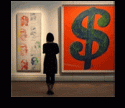Writing an Exhibition Proposal
 Here, the basics of what to include in an exhibition proposal. Here’s a simple way to get a feel for the components of a proposal. Remember those five W’s from elementary school journalism: Who, What, When, Where, Why (and How).
Here, the basics of what to include in an exhibition proposal. Here’s a simple way to get a feel for the components of a proposal. Remember those five W’s from elementary school journalism: Who, What, When, Where, Why (and How).
Who are you? What is the actual exhibit you are proposing? When is it available? Where are you applying (e.g., is your proposal a good fit with the venue’s mission statement and audience?) and Why do you think it’s a good fit? How will you mount the exhibit, and how you will meet other venue criteria, such as educational components?
(Note: Many venues have an actual proposal form to be filled out, and much of this information will be requested on it.)
So your proposal could include:
- Cover letter: Brief, succinct, indicating that this is a proposal to be considered for exhibition. Introduce the artist(s), the artwork, the proposal, and how it fits with the venue’s mission statement, including relevant ties to the venue (local/regional/national). (For example, a local venue may focus on local talent or be more open to a proposal from an emerging artist. If you have national or international stature, you may be more attractive to a national venue. Note: You may want to keep the actual proposal separate from the cover letter.)
- Theme or description of work (the artist’s intent for the exhibit)
- Dates exhibit is available
- Contact info
- CV, resume, and/or bio, whichever the venue has specified
- Artist statement
- Images (10-29 slides or a CD of high-resolution digital images, and perhaps a few good photographs as well) OR a list/description/sketches of proposed works (preferably with images of examples of work from past exhibits). Be sure to provide a reference sheet for all images.
- SASE (self-addressed, stamped envelope) for return of materials
- A list of items in the packet is helpful. You may even want to indicate those materials you prefer returned (images, for example) and those that can be discarded, or whether the venue can keep your materials for future consideration.
The following are optional items that can be left until a venue expresses strong interest in your proposal (unless they are required on the venue’s form).
- Articles on the artist and previous exhibits
- Educational elements of the exhibit, and/or whether the artist is available for workshops, classes, or lectures. (Some venues look for or even require a strong educational element or community outreach in their exhibitions. Being available for these can make you a more attractive candidate.)
- Professional letters of reference
- Information addressing any financial concerns. Will you need funding? Are you applying for grants? Do you have any gallery sponsorship?
A few words about presentation: Take the time to find out to whom you should address your proposal and the correct address. All written materials should be typed, not handwritten (except for comments that are part of a sketch, and these should be legible). Proofread your documents for errors, grammar, spelling. Use a simple binder or packet to organize all materials neatly. Clearly mark or label all materials with your name and contact info in case they get separated from the packet. (Address labels work well for this.)
Know the required format for images and its disadvantages. Slides have been the gold standard for years, but that’s changing fast in the digital age. Plus, if a projector and screen, or magnifying loupe and light table, aren’t handy, your slides may be simply held up to a light for viewing. Voila! Your beautiful work is now confined to a 2-inch image. Even if the venue requests slides or digital images, it doesn’t hurt to also include several large-format photographs to pique interest quickly.
Use professional-quality photographs (not blurry snapshots or slides cropped with masking tape), and present them properly: slides in a clear slide-holder sleeve (not loose in a paper envelope). And images should be labeled. (Some venues prefer slides to be printed/written with your information because stick-on labels can come off and jam their slide projectors.)
* Courtesy FiberArts Magazine
About the Author: Luann Udell is a fiber artist and jewelry designer in Keene, New Hampshire. She writes and blogs regularly about the business of art and the artist’s life.



